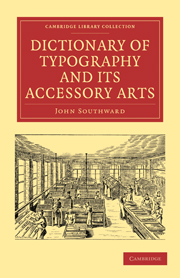Summary
EAR OF THE FRISKET.—A small piece of iron which projects from the edge of the frisket nearest to the workman, and otherwise called the thumb-piece. By taking hold of it he turns down both the frisket and the tympan. After the sheet has been printed, he raises the tympan, and then nimbly turns up the frisket again by means of the ear.
EIGHTEENMO.—A sheet of paper folded into eighteen leaves, making thirty-six pages. It is usually termed eighteens, from being written 18mo.; but is sometimes more correctly called Octodecimo.
ELECTROTYPING.—A process which has come into use in place of, or auxiliary to, stereotyping, to which it is superior in two ways, especially for woodcuts or newspaper headings. The copy or plate being of copper, and therefore much harder than type metal, long numbers can be more profitably and clearly produced; and the strokes being finer, and the sunk parts deeper, the impression from an electrotype more nearly approaches one from the type or engraving itself. The art of plating by electrotype was invented almost simultaneously by Spencer, of Liverpool, and Professor Jacobi, of St. Petersburg, in 1837; made public by the latter, October, 5th, 1838, and by the former, September 12th, 1839. Murray applied blacklead to non-metallic bodies as a conducting surface in January, 1840, and in the following April the first specimen of printing from an electrotype appeared in a London periodical.
- Type
- Chapter
- Information
- Dictionary of Typography and its Accessory Arts , pp. 28 - 35Publisher: Cambridge University PressPrint publication year: 2010First published in: 1875



